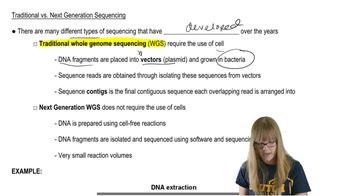True or False:All bacterial cells within a bacteria colony grown on a plate in a laboratory are genetically identical.
Table of contents
- 1. Introduction to Genetics51m
- 2. Mendel's Laws of Inheritance3h 37m
- 3. Extensions to Mendelian Inheritance2h 41m
- 4. Genetic Mapping and Linkage2h 28m
- 5. Genetics of Bacteria and Viruses1h 21m
- 6. Chromosomal Variation1h 48m
- 7. DNA and Chromosome Structure56m
- 8. DNA Replication1h 10m
- 9. Mitosis and Meiosis1h 34m
- 10. Transcription1h 0m
- 11. Translation58m
- 12. Gene Regulation in Prokaryotes1h 19m
- 13. Gene Regulation in Eukaryotes44m
- 14. Genetic Control of Development44m
- 15. Genomes and Genomics1h 50m
- 16. Transposable Elements47m
- 17. Mutation, Repair, and Recombination1h 6m
- 18. Molecular Genetic Tools19m
- 19. Cancer Genetics29m
- 20. Quantitative Genetics1h 26m
- 21. Population Genetics50m
- 22. Evolutionary Genetics29m
5. Genetics of Bacteria and Viruses
Working with Microorganisms
Problem 4c
Textbook Question
Fifteen bacterial colonies growing on a complete medium are transferred to a minimal medium. Twelve of the colonies grow on minimal medium.
The serine biosynthetic pathway is a three-step pathway in which each step is catalyzed by the enzyme product of a different gene, identified as enzymes A, B, and C in the diagram below.

Mutant 1 grows only on min + Ser. In addition to growth on min + Ser, mutant 2 also grows on min + 3-PHP and min + 3-PS. Mutant 3 grows on min + 3-PS and min + Ser. Identify the step of the serine biosynthesis pathway at which each mutant is defective.
 Verified step by step guidance
Verified step by step guidance1
Step 1: Understand the serine biosynthetic pathway diagram. The pathway starts with 3-Phosphoglycerate, which is converted to 3-Phospho-hydroxypyruvate (3-PHP) by Enzyme A. Then, 3-PHP is converted to 3-Phosphoserine (3-PS) by Enzyme B. Finally, 3-PS is converted to Serine (Ser) by Enzyme C.
Step 2: Analyze the growth patterns of the mutants. Mutant 1 grows only when provided with 3-PS, indicating it cannot synthesize 3-PS from 3-PHP. This suggests a defect in Enzyme B.
Step 3: Mutant 2 grows when provided with 3-PHP or 3-PS, indicating it cannot synthesize 3-PHP from 3-Phosphoglycerate. This suggests a defect in Enzyme A.
Step 4: Mutant 3 grows when provided with 3-PS or Serine, indicating it cannot synthesize Serine from 3-PS. This suggests a defect in Enzyme C.
Step 5: Assign the defective step for each mutant based on the analysis: Mutant 1 is defective in the step catalyzed by Enzyme B, Mutant 2 is defective in the step catalyzed by Enzyme A, and Mutant 3 is defective in the step catalyzed by Enzyme C.
 Verified video answer for a similar problem:
Verified video answer for a similar problem:This video solution was recommended by our tutors as helpful for the problem above
Video duration:
2mPlay a video:
Was this helpful?
Key Concepts
Here are the essential concepts you must grasp in order to answer the question correctly.
Serine Biosynthetic Pathway
The serine biosynthetic pathway is a metabolic route that converts 3-phosphoglycerate into serine through a series of enzymatic reactions. This pathway involves three key enzymes, A, B, and C, each catalyzing a specific step. Understanding this pathway is crucial for identifying where mutations may disrupt serine production in bacterial mutants.
Recommended video:
Guided course

Repair Pathways
Mutant Analysis
In genetics, mutant analysis involves studying organisms with specific genetic alterations to determine the effects on metabolic pathways. By observing which media the mutants can grow on, researchers can infer which enzymes are functional or defective, thus pinpointing the specific step in the biosynthetic pathway that is affected by each mutation.
Recommended video:
Guided course

Chi Square Analysis
Minimal vs. Complete Medium
Minimal medium contains only the essential nutrients required for growth, while complete medium provides additional nutrients, including amino acids like serine. The ability of bacterial colonies to grow on minimal medium indicates their capacity to synthesize necessary compounds, such as serine, which is vital for understanding the implications of mutations in the serine biosynthetic pathway.
Recommended video:
Guided course

Traditional vs. Next-Gen

 9:35m
9:35mWatch next
Master Bacteria in the Laboratory with a bite sized video explanation from Kylia
Start learningRelated Videos
Related Practice
Multiple Choice
591
views
3
rank
